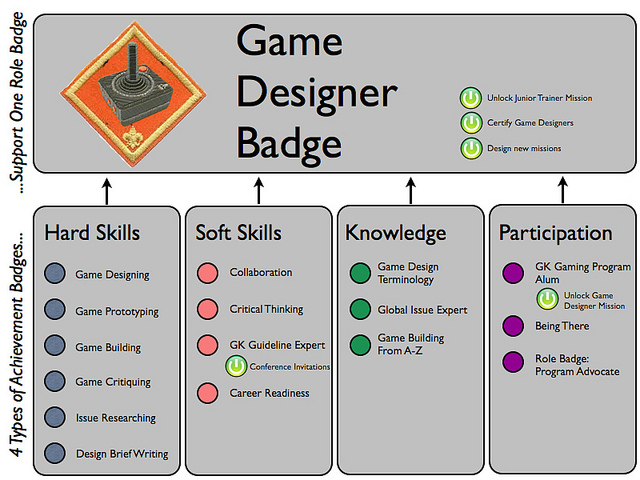Today we had our first meeting (dare we say of our fourth badging group – the Badge Betas?) of the four summer projects which will beta test the program over the summer. There are two 2-week long digital media-based programs, a 3-week long intensive camp at the Council on Foreign Relations, and a four week trip to Kenya. We developed templates for creating badges – one for any individual badge and one for the constellation of badges that are to found within any one Global Kids program (and tied to the “role badge” earned in the process), designed to produce something like this:
For example, the animation program wanted a badge for taking inspiration from a professional animator. That was generalized to something like the “Standing on the Shoulder of Giants” badge, in which the mission, when used for this summer program, will challenge the youth to list an animator who inspired them. However, the same badge can be used for the program at the Council on Foreign Relations, with a mission localized for their program, e.g. “To discuss one of the program speakers who inspired them and explain why.” Same badge, different missions.
It became clear that, as an overall direction, we want to have as small a number of badges as possible, by globalizing their use, but as many missions as we like, localizing their youth. We need to make sure the badges are clear and specific (otherwise we have squished too much together) and that the missions assess equal levels of related achievements so the badge can maintain validity across programs.
So while today’s meeting was aimed at developing project-specific badges it also helped us develop, in a very concrete and practical way, badges that can provide global value across the organization.
When we next meet we intend to refine our program’s badge ecology (most were too robust to develop in time for and run during rather short summer programs) and note what other badges we can globalize and share across our programs. The next steps after that is to identify the 8 characteristics we need for each badge and then move them over into LearningTime’s Badgestack system.
Two trainers, both rather new to GK’s badging process, had this to report about today’s process: “Thinking about the upcoming program in terms of badges is informing how we will shape the program,” “This helps me to reflect on last year’s program and the educational goals for this year,” and “This will give youth tangible things to let them know they are on the right track, rather than us having to tell them over and over when they are not.”


No Comments